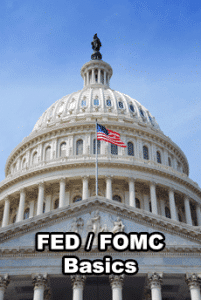
Who Is The Fed? And What Does The FOMC Do?
The key to understanding the Fed and the Federal Open Market Committee (FOMC) is to know that all the cash in the country and the world is only a small fraction of the amount of money in the economy at any given time.
Most of the money in the economy is an entry in a bank ledger somewhere. The way that all of this is organized and supervised is the responsibility of the Federal Reserve (the Fed) and the FOMC.
The Fed has been in charge of United States monetary policy since 1913. There are two parts of the system for decision making about how America handles its currency policy and the basic rules about banking.
The Job Of The Board Of Governors
The Board of Governors of the Federal Reserve are the joint-captains, responsible for setting the rate at which banks can borrow money to lend and invest. They also dictate reserve requirements for funds that can be withdrawn by customer at any given time. The chair of the board of governors is currently Janet Yellen.
When Banks Borrow From The Fed
The discount rate is the rate at which banks can borrow money from the government. There are three rates the lowest is the primary rate or overnight rate that granted to the most solid and powerful financial institutions. Next is the secondary rate which banks that cannot get the primary discount rate will generally receive money at.
The last is the higher seasonal rate at which smaller banks can borrow money to cover fluctuating needs when they need it most throughout the year. The rates are what determine the lending rates on investment securities throughout the world. A change in the primary rate will ripple across markets like few other things can.
Reserve Requirements
The banks are not required to have on hand all of the funds that are held in savings deposits, the reserve requirement set by the Board of Governors is only a small fraction of the funds that they have on the books. The banks use most of the money they have on ledger to lend to borrowers.
This is the reason that banks sometimes seem keen to lend money and other times less so; it all comes down to the cash they have on hand compared to the fractional reserve requirement of what they must hold.
The fractional reserve system generally works well, as long as it remains constant. Even a slight increase in the reserve requirement could send banks scrambling to call in their markers to find the extra reserves. Changing reserve requirements can have disastrous consequences and it is a serious duty that the Fed handles very carefully.
Open Market Operations
Open market operations (OMO) are the practice of selling and then buying back the bonds in an open market. This is the purview of the FOMC, the committee supervises the open market for government securities.
The three different tools of the Fed are the way that they control the conditions of the economy. It is important to home owners and borrowers because it is the basis of the rates of interest and the strength of the economy that make it ultimately possible to finance a home loan.



About The Author: Kenneth Le
More posts by Kenneth Le